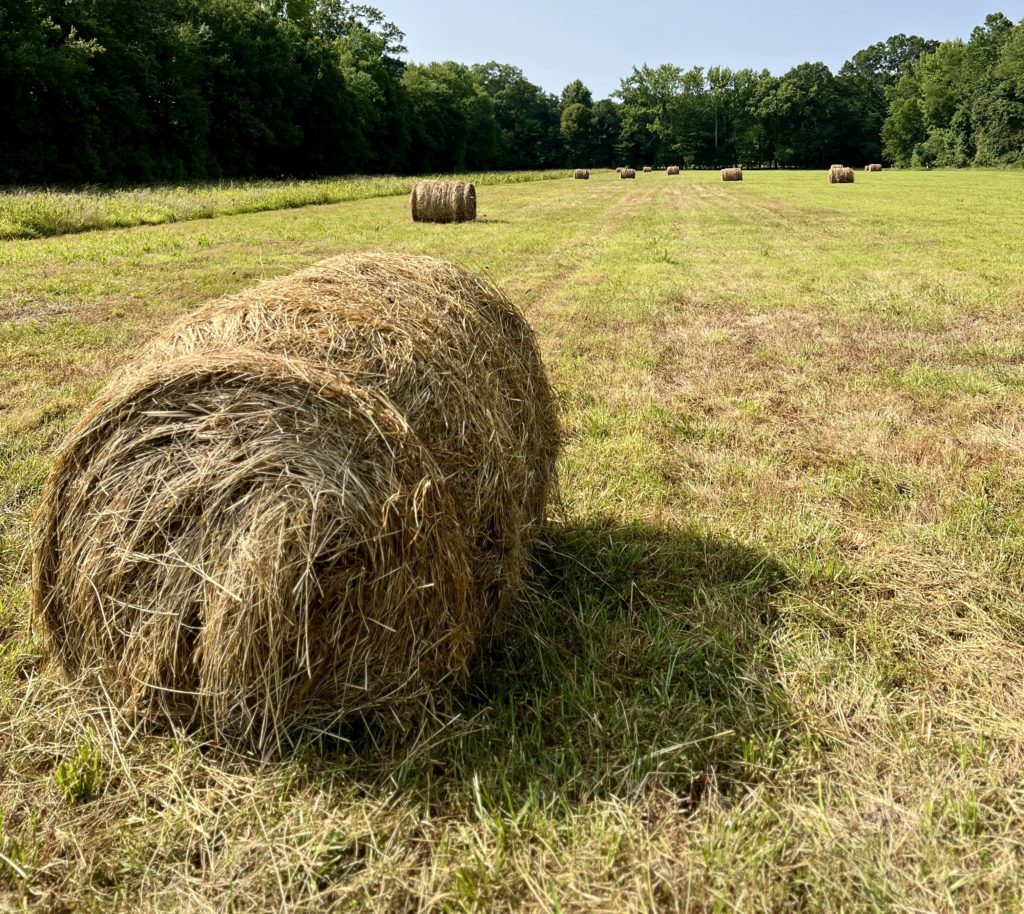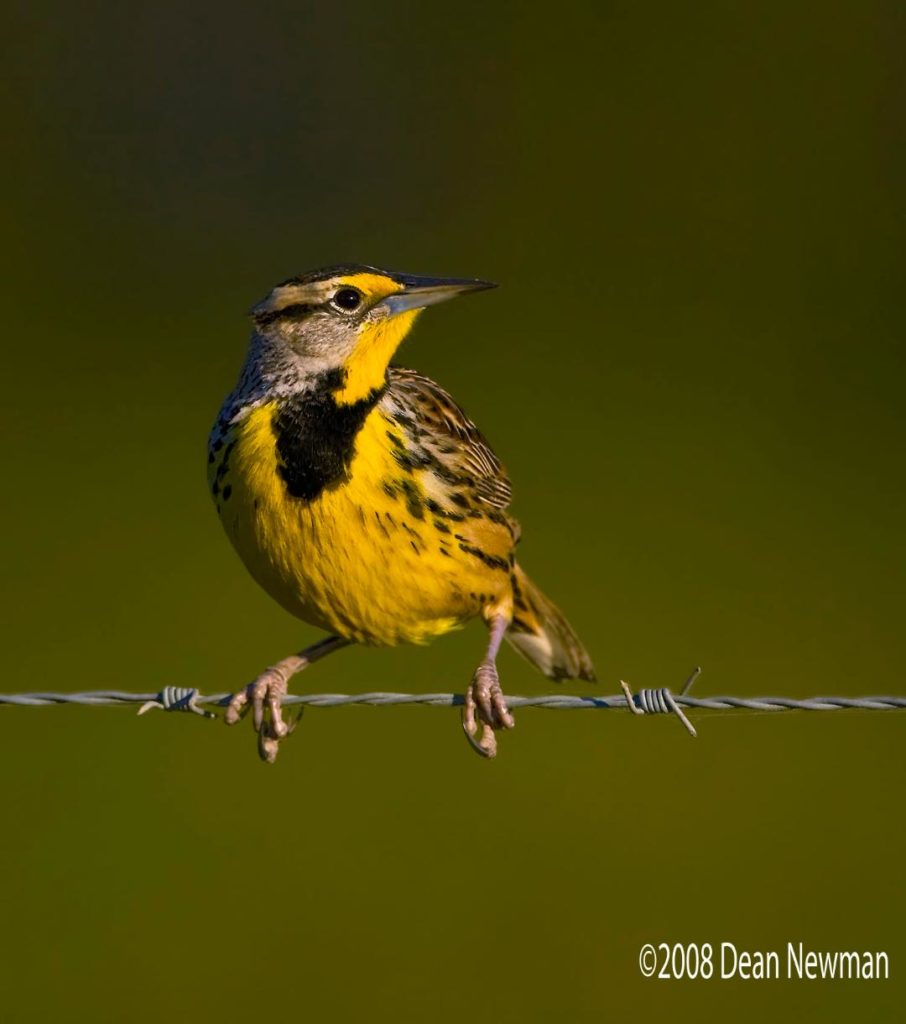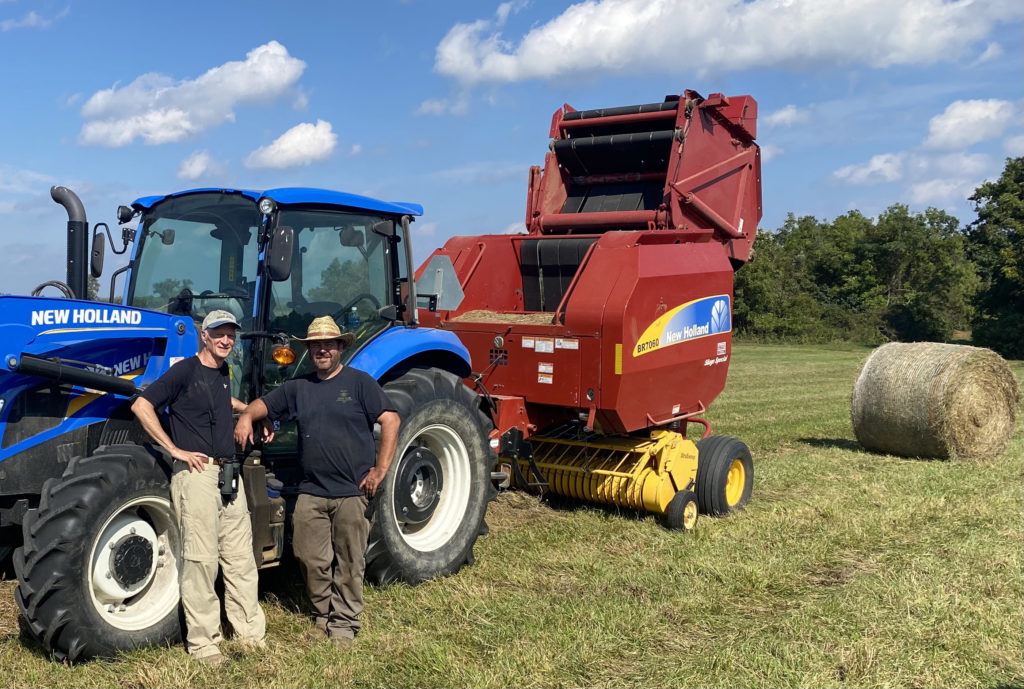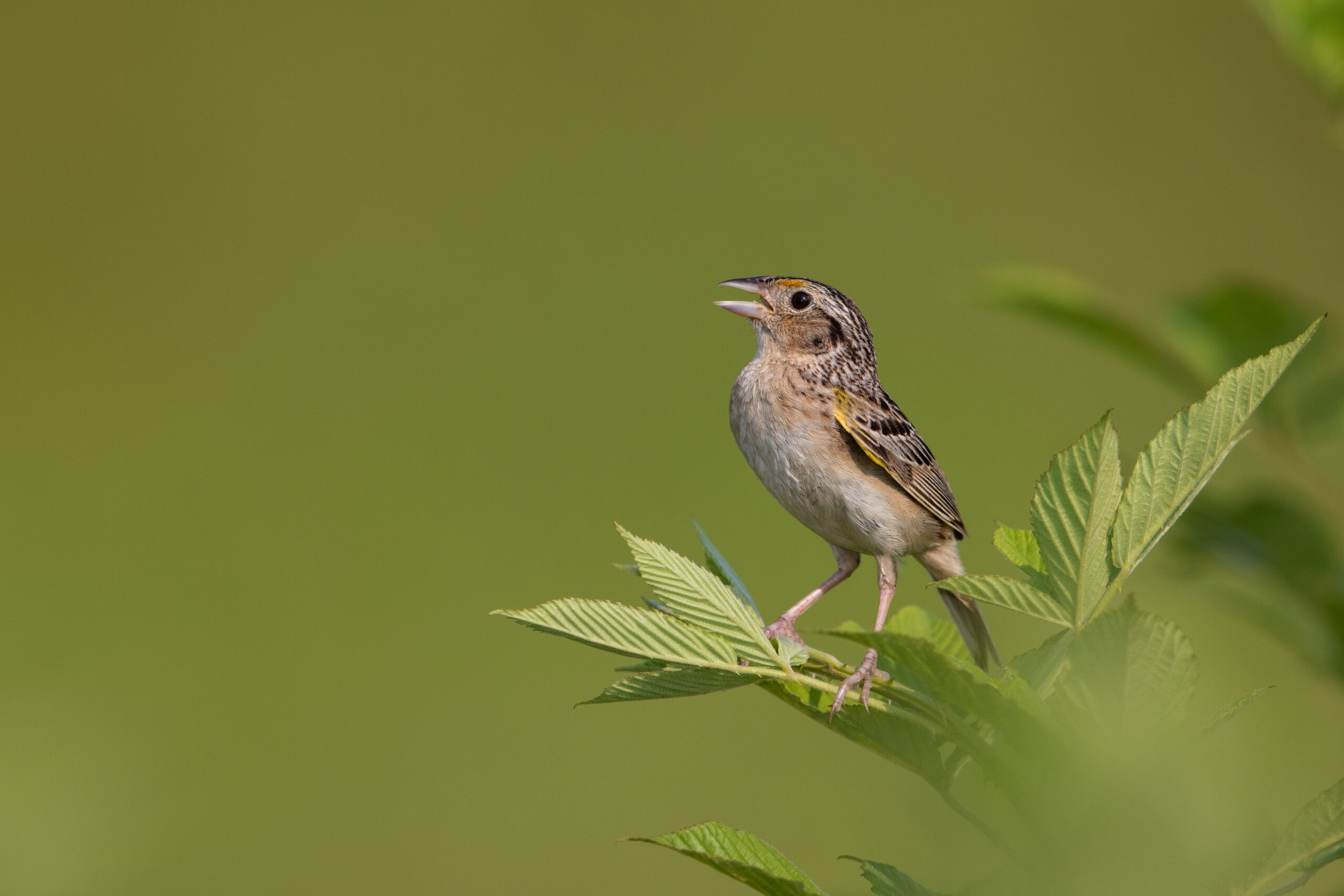Grassland Birds species have decreased 53% in North America since 1970. A major reason for this decline has been the loss of hayfields to development. The Southern Maryland population of grassland birds– primarily the Eastern Meadowlark and Grasshopper Sparrow– reflects this larger trend. These birds have suffered drastic declines and are listed as “Species of Greatest Conservation Need” by the Maryland State Wildlife Action Plan.
Southern Maryland Audubon Society, in partnership with the Patuxent Tidewater Land Trust, Historic Sotterley, and the Farmers Feeding Southern Maryland organization, is working to find practical solutions that balance the needs of hay farmers and birds so that both can thrive.
The sections below discuss these collective efforts: Bale Hay without Baling Birds, the Grassland Ambassadors program, Five Steps – A Landowners Guide to Bird-Friendly Hay Management, and our letter to farmers seeking participation.

Strategy to Bale Hay without Baling Birds
Using fact-based decision-making, it is possible to make small adjustments to haying operations to improve grassland bird nesting success. Eastern Meadowlarks and Grasshopper Sparrows breed successfully in large hayfields of 20 acres or more. The peak breeding period is mid-May to mid-June. Therefore, the first mowing in May/June can be particularly lethal, destroying eggs, nests, and recently hatched young that cannot escape the repeated passes of heavy equipment. During this period, these ground-nesting birds are particularly vulnerable to haying operations.
From the landowners’ perspective, there are actions that can be taken to maintain the value of their crop while reducing bird mortality. It begins with getting good information about which birds are using which fields, and what harvesting techniques are particularly beneficial to the birds. That is why we have established a program to share information about grassland birds that rely on nesting in hayfields and to explore hay management options that might work for some landowners, depending on their priorities. We call this our Grassland Ambassadors program.
Grassland Ambassadors

Our team of Grassland Ambassadors is prepared to visit any landowner in Southern Maryland on request to determine whether their fields are hosting nesting Meadowlarks, Grasshopper Sparrows, Barn Owls, Kestrels, Dickcissels or other grassland-dependent species. Our Ambassadors will share options for harvesting that increase nesting success while maintaining necessary hay harvest.
And if your property looks right for a nesting box for Barn Owls or American Kestrels, our Grassland Ambassadors can give you advice on how to install one or provide you with a nesting box and improve the habitat for the grassland-dependent raptors.
To get started, just contact our Saving Grassland Birds program at Ambassadors.somdaudubon@gmail.com and ask for a visit from a Grassland Ambassador.
Five Steps: A Landowners Guide to Bird-Friendly Hay Management
1. Adjust hay harvest timing to avoid the peak breeding season
Delaying the spring mowing to either side of the peak-breeding season is a big ask of some landowners but provides the most direct benefit to birdlife. Even if a landowner delays the harvest a week or two, the birds will benefit as long as the mowing takes place further away from the breeding peak.
For those with the option to do more, the USDA offers an economic incentive to delay spring mowing until July 15 to partially compensate for the loss of product. For more information about this program, call your local Natural Resource Conservation Service (NRCS) office or visit this website: www.md.nrcs.usda.gov.
2. Sequence the mowing of multiple fields
When scheduling the mowing of more than one field, first assess which fields are the best or worst for breeding grassland birds. Research has shown that in Southern Maryland, Eastern Meadowlarks and Grasshopper Sparrows are most likely to use fields of greater than 20 acres, and unbroken by trees, hedgerows or buildings. If practical, first mow the smaller fields that are least likely to be used by nesting grassland birds and save the largest fields for last and latest. For example, if a haying contractor has 4 fields to mow – one of which is 100 acres unbroken by trees or buildings, while the others are smaller and divided by forests or hedgerows – then mowing the big unbroken field after the peak breeding season can reduce grassland bird mortality significantly.
3. Increase the height of the cutting blade
Increase the heigh of the cutting blade. Raising the cutting height reduces hay production somewhat but has two important benefits. First, it reduces the likelihood of direct destruction of both nests and breeding birds by the mower. Second, it hastens drying by laying the cut hay on higher stubble.
4. Use “flushing bars” and avoid high speeds
As mowing technology has evolved from sickle bar to disc mowers, so has the ability to increase speed on the field. This makes it difficult for breeding birds to flush and escape the mowing blades. One solution encouraged by USDA/NRCS is to attach a “flushing bar” on the front of the tractor. The “flushing bar” is a horizontal bar with chains, cables or belts hanging down to the ground to flush birds from their nests as the mower approaches. But whether or not a “flushing bar” is used, slowing mowing speeds will increase the escape time for nesting birds.
5. Leave an un-mowed “refuge” in the biggest fields
Eastern Meadowlarks and Grasshopper Sparrows both tend to set up breeding territories towards the center of large hayfields, so it makes sense to leave a circle of several acres of unmowed grass in the center of a large hayfield. This not only will preserve some active nests but also hastens re-nesting during the same breeding season at only a modest cost to the bottom line.

discuss bird-friendly mowing.
Letter to Farmers
Dear
As the owner of a large hayfield in Southern Maryland, you may have an opportunity to manage your land to increase the nesting success of grassland birds – raptors such as American Kestrel and Barn Owl, and small songbirds such as Eastern Meadowlarks and Grasshopper Sparrows. Grassland species are in steep decline and really need our help.
These are iconic birds of agricultural heritage, returning to Southern Maryland every spring to raise their young and devour insect pests. Meadowlarks and Grasshopper Sparrows feed on insects and are hard-wired to nest in the middle of hayfields, preferably fields larger than 20 acres. Kestrels and Barn Owls also prefer open grassland, searching for small rodents. As open agricultural land slowly converts to row crops or housing developments, these birds have become more and more reliant on the management practices of owners of hayfields and meadows that give the birds a better chance to survive the nesting season and successfully reproduce.
We know that every owner of a hayfield has his/her own priorities for why, when, and how to manage the land, and limiting the mortality of birds that nest there may not be something you have ever considered. Would your grasslands support a Barn Owl nesting box? Would nesting field birds such as Meadowlarks benefit from mowing one of your hayfields later than others?
If you have any interest in improving the conservation of the birdlife using your fields, send us an email. We would send one of our “Grassland Ambassadors” to visit with you to do an initial assessment of which species are present and of what alterations to their habitat would benefit the birds but also fit within your management priorities.
Thanks for considering this. We would love to continue this conversation at any time.
Sincerely,
Dean Newman Mike Callahan
Co-chair (Hayfield Nesters) Co-chair (Raptors)
Grassland Ambassadors Grassland Ambassadors
Contact: Email: Ambassadors.SOMDAudubon@gmail.com
Address: Southern Maryland Audubon Society
P.O. Box 181 Bryans Road, MD 20616
More Resources
Natural Resources Conservation Program Maryland (https://www.nrcs.usda.gov/wps/portal/nrcs/site/md/home/) Incentives to adjust mowing schedules to benefit grassland birds are available from the EQIP (Environmental Quality Incentives Program).
Atwood, J. et al, “Best Management Practices for Nesting Grassland Birds”, 2017, Mass Audubon, Lincoln, Massachusetts. https://www.massaudubon.org/our-conservation-work/wildlife-research-conservation/bird-conservation-monitoring/grassland-birds. This is a clear and concise pamphlet for managers of public lands that uses illustrations of different farm management techniques to minimize the disturbance of nesting grassland species in New England.
Cornell University Cooperative Extension, “Enhancing Pastures for Grassland Bird Habitat”, Prepared by Jim Ochterski, January 2005. While this monograph focuses on pasture rather than hayfield management in New York, many of its recommendations apply to bird-friendly hayfield management on any farm in the Eastern states.
Cornell University Cooperative Extension, “Hayfield Management and Grassland Bird Conservation”, Prepared by Jim Ochterski, January 2006. New York focus on strategies to align farmer needs with the needs of grassland birds.
Ellison, W.G., ed., 2d Atlas of the Breeding Birds of Maryland and the District of Columbia, The Maryland Ornithological Society and The Johns Hopkins University Press, 2010. pp 384-85 (Grasshopper Sparrow), 416-17 (Eastern Meadowlark).
Gruntorad, M.P. et al, “Is Hay for the Birds? Investigating Landowner Willingness to Time Hay Harvests for Grassland Bird Conservation”, article in Animals, 5 April 2021. https://doi.org/10.3390/ani11041030. Survey of landowners in the Great Plains found that a majority (60%) of respondents expressed willingness to delay harvesting hay to allow birds time to nest successfully.”
Hull, S.D. 2000 (revised 2002). “Effects of Management Practices on Grassland Birds: Eastern Meadowlark”, Northern Prairie Wildlife Research Center, Jamestown, ND. 35 pp. Downloadable at https://digitalcommons.unl.edu/empgb/. A useful synthesis of literature up to 2002, but with a strong regional focus on the Midwest and Dakotas.
Iliff, M.J., Ringler, R.F., and Stasz, J.L., Field List of the Birds of Maryland, Maryland Ornithological Society, Third Edition, 1996, downloadable at https://www.biodiversitylibrary.org/bibliography/119538#/summary
Perlut, N., “Management Considerations for Grassland Birds in Northeastern Haylands and Pasturelands”, NRCS Agricultural Wildlife Conservation Center, June 2010. https://www.bobolinkproject.com/docs/NRCS_Grassland_leaflet.pdf.
An excellent summary of timing strategies to promote grassland bird breeding success in Vermont, including the notable NRCS Vermont adaptation of the EQIP program such that farmers could receive a $135 per acre incentive payment (as of 2010) if the first mowing occurred early and the second mowing occurred no less than 65 days later.
Perlut, N. et al, “A Model for Integrating Wildlife Science and Agri-Environmental Policy in the Conservation of Declining Species”, The Journal of Wildlife Management 75(7):1657-1663, 2011. https://wildlife.onlinelibrary.wiley.com/doi/abs/10.1002/jwmg.199. Detailed description of the innovative use of EQIP by the NRCS in Vermont to demonstrate the beneficial impact of early mowing followed by a 65-day delay to second mowing. Bobolink reproductive rates improved from 0.0 to 2.8 fledglings per female per year.
Peterjohn, B. May 2006. “Conceptual Ecological Model for Management of Breeding Grassland Birds in the Mid-Atlantic Region”. Technical Report NPS/NER/NRTR–2006/005. National Park Service. Philadelphia, PA. 56 pp. This is a thorough and informative review of management strategies for publicly-owned land with grasslands suitable for grassland birds.
Robbins, C.S, ed., and Blom, E.A.T., “Atlas of the Breeding Birds of Maryland and the District of Columbia”, University of Pittsburgh Press, 1996. pp 398-99 (Grasshopper Sparrow), 416-17 (Eastern Meadowlark).
Strong, A. and Perlut, N., “Delay Hay Cuttings to Allow Birds to Successfully Fledge Young”, NRCS Agricultural Wildlife Conservation Center, https://www.nrcs.usda.gov/Internet/FSE_DOCUMENTS/nrcs143_010033.pdf. A summary of the impact of hay cutting timing on the breeding success of Savannah Sparrows and Bobolinks in Vermont.
Virginia Working Landscapes, “Field Management Guidelines for Virginia’s Grassland and Shrubland Birds”, https://www.vaworkinglandscapes.org/. A clearly-presented guide intended for landowners who are interested in helping grassland birds and have some flexibility in their management approaches. “Even just choosing to implement one of the practices listed below can have a positive impact.”
Ongoing Projects Elsewhere
Ag Allies, a project of the Somerset County Soil and Water Conservation District, Somerset County, Maine, under the direction of Laura Suomi-Lecker. “We seek to empower landowners to make sustainable bird-friendly management changes on their land and improve the opportunity for nesting success of grassland birds.”
The Bobolink Project, a project of Mass Audubon, Audubon Vermont and New Hampshire Audubon. Over 10 years, private donors have funded an auction that now supports the protection of over 1000 acres. Hay farmers bid to receive payments to compensate them for losses associated with delaying haying to allow grassland birds to breed.
Brandywine Conservancy, a land trust in Pennsylvania that includes a focus on adapting the timing of haying to the breeding requirements of grassland birds.
Ontario Ministry of Natural Resources and Credit Valley Conservation. “Bird-Friendly Certified Hay” programs. This is an innovative market-based approach which seeks to match landowners with hay buyers to facilitate “Bird-Friendly Certified Hay” – No mowing between May 1 and July 15.
Vermont Center for Ecostudies, has initiated the New England Grassland Ambassadors program, which helps landowners identify strongholds of grassland bird habitat and enlists willing landowners to enhance that habitat in economically feasible ways.
Virginia Working Landscapes, a program of the Smithsonian Conservation Biology Institute, Front Royal, VA. Under the direction of Amy Johnson, VWL has built up a strong outreach program that communicates research findings to inform best management practices for landowners and conservation partners.
